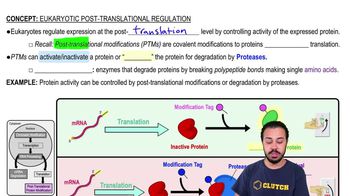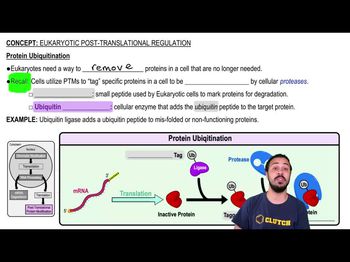Eukaryotic Post-Translational Regulation definitions Flashcards
 Back
BackTerms in this set (21)
Post Translational Modification
Chemical modifications of proteins after synthesis, altering their function, location, activation state, or degradation, thus regulating gene expression.
Protein Function
The role a protein plays in a cell, influenced by its structure and modifications, affecting its activity, location, interactions, and stability.
Protein Location
Refers to the specific area within a cell where a protein functions, often determined by post-translational modifications like tagging with molecules that direct its cellular destination.
Sugar Molecules
Sugar molecules are carbohydrate tags added to proteins, directing their cellular location and function, often guiding them to the plasma membrane.
Phosphorylation
Adding or removing a phosphate group to a protein, often acting as an on/off switch to regulate the protein's activity, location, or function within the cell.
Phosphate Group
A chemical group consisting of one phosphorus atom bonded to four oxygen atoms, crucial for energy transfer, signaling, and protein activation/deactivation in cells.
Protein Activation
The process by which a protein's function is regulated through the addition or removal of chemical groups, often acting as an on/off switch.
Protein Inactivation
The process by which a protein's function is halted, often through post-translational modifications like phosphorylation, acting as a reversible on/off switch.
Protein Degradation
The process by which cells tag unwanted proteins with ubiquitin, signaling them for breakdown and recycling by the proteasome.
Ubiquitination
Attachment of ubiquitin molecules to a protein, marking it for degradation by the proteasome, thus regulating protein levels and function within the cell.
Ubiquitin
A small protein that tags other proteins for degradation, signaling the cell to destroy them when they are no longer needed.
Gene Expression
The process by which information from a gene is used to synthesize functional gene products, often proteins, which can be regulated at multiple stages, including post-translational modifications.
Hormone Signal
A biochemical message that triggers cellular responses, such as protein production, modification, or degradation, to regulate physiological processes.
Repressor Protein
A protein that binds to specific DNA sequences to inhibit the transcription of a gene, thereby regulating gene expression.
Transcription
The process of copying a segment of DNA into RNA, primarily mRNA, by the enzyme RNA polymerase, enabling gene expression.
Protein X
A protein produced in response to a hormone signal, later tagged with ubiquitin for degradation when no longer needed by the cell.
mRNA
A molecule that carries genetic information from DNA to the ribosome, where it serves as a template for protein synthesis.
Micro mRNA
Small RNA molecules that bind to complementary mRNA sequences, preventing their translation and thus regulating gene expression post-transcriptionally.
Translation
The process where mRNA is decoded by ribosomes to synthesize a specific polypeptide, following the genetic instructions from DNA.
Cell Membrane
A semi-permeable barrier that regulates the entry and exit of substances, maintaining the internal environment of the cell.
Semi Permeable
Allows selective passage of certain molecules while blocking others, maintaining cellular homeostasis.


